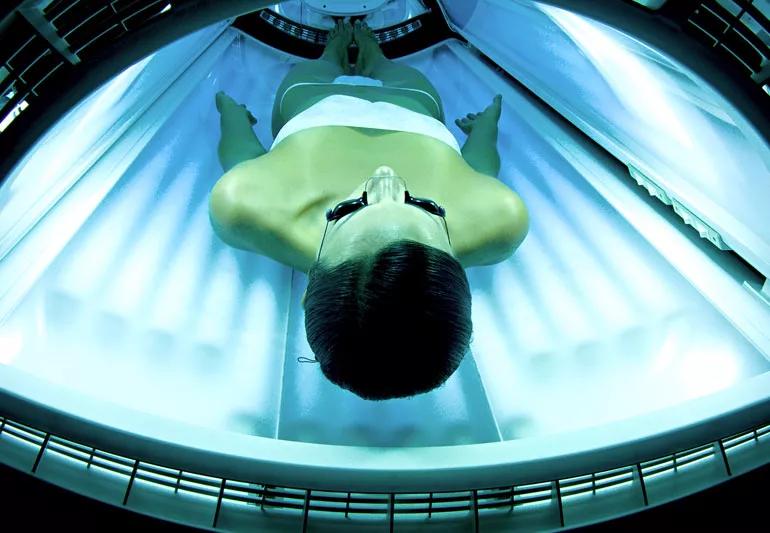The simple, straightforward and hard-lined answer is no

You may be tempted to hop in a tanning bed for a few minutes to get to a little mid-winter color or establish a base tan before you hit the pool or beach.
Advertisement
Cleveland Clinic is a non-profit academic medical center. Advertising on our site helps support our mission. We do not endorse non-Cleveland Clinic products or services. Policy
But think again.
The risks of using tanning beds could be deadly. Still, one study found that 90% of people who use tanning beds know the health risks and keep using them anyway.
Dermatologist Jennifer Lucas, MD, breaks down the very serious health concerns associated with using tanning beds and why the pursuit of a bronzed hue just isn’t worth it.
“The short answer is, yes, tanning beds are just as harmful as the sun, if not more harmful,” Dr. Lucas says.
Both the sun and tanning beds emit ultraviolet (UV) radiation. UVA rays (short for ultraviolet A) are the ones responsible for tanning, burning and, ultimately, wrinkling your skin. Too much exposure to them leads to skin cancer. And tanning beds emit 10 to 15 times more UVA rays than the sun — so they’re definitely not safer than the sun.
Intentional UV exposure is unsafe, period, even if you only do it every once in a while. In fact, using a tanning bed even one time before age 35 raises your risk of developing melanoma by a stunning 75% — and that risk goes up every time you do it.
“There is just no such thing as a safe tan,” Dr Lucas reiterates.
“There are so many reasons to avoid tanning beds,” Dr. Lucas says. Shall we count the ways? Tanning beds are known to increase your risk for skin cancer, cause problems with your eyes and prematurely age your skin.
Advertisement
Dr. Lucas delves deeper into the risks of using tanning beds.
You probably already know that tanning bed use is linked to an increased risk of skin cancer. But do you know just how serious that risk is?
Dermatologists are seeing skin cancers developing in younger people, which many experts attribute to tanning bed use. Studies have linked tanning bed use to an increased risk of all forms of skin cancers.
The American Academy of Dermatology reports that using a tanning bed raises your chance of squamous cell carcinoma by 58% and of basal cell carcinoma by 24%. And as we’ve already discussed, using tanning beds is also associated with an increased risk of melanoma, the most dangerous type of skin cancer.
“We’re seeing a real, increased risk of melanoma in younger women,” Dr. Lucas states. “It’s hard to know exactly what to attribute that to, but probably the biggest thing we’re seeing is that younger women are the ones in tanning beds.”
If you have a mole that looks different from any others on your body, head to your dermatologist to check it out.
Those colorful, plastic goggles that tanning salons give you to cover your eyes while you’re getting toasted aren’t enough to keep risks at bay.
Using a tanning bed can damage the internal structure of your eyes and eyelids, putting you at risk for conditions like cataracts and ocular melanoma (eye cancer).
To maintain your eye health, take precautions to protect your peepers from harmful UVA rays, like by wearing the right sunglasses and getting yearly eye exams — oh, and by staying out of tanning beds.
Most people go tanning because they think it makes their skin look better. But the way that tanning can impact your skin in the long-term is definitely not the look you want.
“Frankly, we all want to look younger,” Dr. Lucas notes, “but the more UV exposure you get, the more photoaging or damage you do to your skin.”
UVA rays penetrate your skin more deeply and damage collagen, the basic building block of your skin and elastin that helps keep you looking younger. This can cause you to develop dark age spots and leathery, wrinkled skin that make you look much older than you are.
So, what’s the best way to keep your skin looking young and fresh? Protect it.
“You need to respect your skin,” Dr. Lucas says. “Using sunscreen, wearing sun-protective clothing and avoiding the midday sun, in particular, can help prevent skin damage.”
Advertisement
Here’s one final fact to talk you out of using tanning beds: Getting a so-called “base tan,” whether from the sun or a tanning bed, doesn’t even decrease your likelihood of getting sunburned. Only sunscreen (and sun avoidance) can do that.
In other words, tanning is all risk and literally no reward.
If you simply like the way your skin looks with a bronzy glow, you can achieve the same results easily and much more safely. “The safest way to tan is through sunless tanning,” says Dr. Lucas. “I recommend store-bought or professionally done spray tans or lotions and cream to get your healthy glow.”
With such a large variety of sunless products on the market today, there really isn’t any reason to use tanning beds.
Advertisement
Learn more about our editorial process.
Advertisement

Family history matters for melanoma, but the connection isn’t as strong for other skin cancers

Wear UPF clothing, apply sunscreen and try self-tanners instead of tanning beds

Frequent manicures, high-watt bulbs increase potential

The risk is less, but sunscreen is never a bad idea

Anything from minor irritations and chronic diseases to, yes, cancer can cause persistent itching

A sunburn will leave you itchy and red, while sun poisoning can feel like an allergic reaction

The upper lip discoloration is caused by factors like sun exposure, hormones and medications

Make sure you use a high SPF formula, apply enough and reapply throughout the day

Type 2 diabetes isn’t inevitable with these dietary changes

Applying a hot or cold compress can help with pain